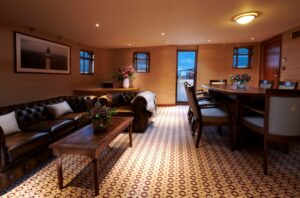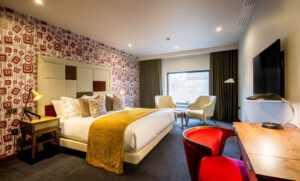Furniture manufacturers design student accommodation furniture with a different approach, which include places like dormitories, student apartments, or shared housing. They tailor this furniture to meet the specific needs of students, making it practical, durable, and space-saving. Common furniture items include beds, mattresses, study desks, chairs, wardrobes, sofas, dining tables, and kitchen appliances. The selection of this furniture prioritizes longevity, ease of maintenance, and cost-effectiveness, taking into account the wear and tear often associated with student living.
Top Nince Trends in Student Accommodation Furniture Design
- Optimizing Space: One of the foremost trends in student accommodation furniture design is the emphasis on making the most of limited space. This includes the creation of loft beds, modular furniture, and versatile pieces that can serve multiple functions.
- Enhancing Comfort through Ergonomics: Another notable trend is the integration of ergonomic features into chairs and study desks, ensuring that students can comfortably work and study for extended periods.
- Personalization and Customization: Modern student furniture also encourages personalization. This allows students to adapt their living spaces to their individual needs and preferences, promoting a sense of ownership.
- Seamless Integration of Technology: Technology integration is becoming increasingly important. Furniture designs now often incorporate built-in charging ports, cable management solutions, and smart storage options, catering to the tech-savvy student lifestyle.
- Durability and Low Maintenance: Contemporary student furniture is designed with durability in mind. It features materials that can withstand the rigors of daily use and are easy to clean and maintain.
- Versatile and Adaptable Designs: Versatility is key, with furniture systems that can be easily reconfigured or expanded to adapt to changing accommodation layouts and student needs.
- Multi-Functional Pieces: There is a growing demand for furniture that serves multiple purposes. Examples include sofa beds, storage ottomans, and dining tables with integrated workspace functionality.
- Aesthetics Aligned with Modern Tastes: Aesthetic preferences are also being addressed, with stylish furniture designs. Furniture designs reflecting contemporary, minimalist, or eclectic styles that resonate with today’s students.
- Fostering Community and Social Interaction: Lastly, furniture arrangements are being crafted to encourage social interaction and collaboration in common areas. This approach promotes a sense of community among student residents.
Durable and Stylish: The Importance of Quality Furniture for Students
- Long-Lasting Comfort: Quality furniture ensures enduring comfort, benefiting students throughout their academic journey.
- Boosting Productivity: Well-constructed furniture enhances productivity, creating a conducive environment for study and work.
- Economical Investment: Investing in durable furniture proves cost-effective in the long term, reducing the need for frequent replacements.
- Enhancing Aesthetics: Stylish furniture not only adds to the visual appeal of student accommodations but also fosters an inviting and motivating atmosphere.
- Safety and Durability: High-quality furniture prioritizes safety and durability, minimizing the risk of accidents or breakage that could disrupt students’ lives.
- Minimal Maintenance: It requires minimal maintenance, allowing students to focus on their studies rather than constantly repairing or replacing worn-out furniture.
- Sustainable Practices: Furthermore, quality furniture often incorporates sustainable materials and practices, aligning with environmental concerns.
- Customization Options: Many high-quality furniture pieces offer customization options, enabling students to personalize their living spaces.
- Value for Money: Despite a potentially higher initial cost, quality furniture offers exceptional value for money due to its durability and longevity.
- Enhancing Well-Being: Comfortable and visually pleasing furniture positively influences students’ well-being, creating a more enjoyable living and learning experience.
Customizing Your Student Accommodation Furniture to Suit Your Style
Customizing student accommodation furniture involves personalizing furniture items to suit one’s individual style and preferences. This process allows students to create a living space that is distinctive and reflective of their personality. Customization options can encompass alterations in furniture design, color, and functionality, all with the aim of improving both comfort and aesthetics. By personalizing their furniture, students have the opportunity to express themselves and feel more at ease and connected with their living environment.You can achieve this customization without exceeding budget limitations, and you should integrate it harmoniously with the existing room decor to create a cozy and inviting personal space..
Creating Functional and Stylish Common Areas with Accommodation Furniture
- Versatile Seating Arrangements: Implementing seating that can be easily adapted to suit various activities.
- Collaborative Workspaces: Establishing designated workspaces equipped with comfortable seating and ample desk space to promote group study and collaborative projects.
- Ergonomic Comfort: Integrating furniture designed for comfort during long study sessions, with a focus on ergonomics.
- Aesthetic Appeal: Selecting stylish furniture that complements the overall decor and creates an inviting atmosphere in shared areas.
- Space Optimization: However, Utilizing space-efficient furniture solutions to make the most of available communal spaces.
- Tech-Friendly Features: Incorporating amenities like charging stations and cable management to accommodate modern students’ technological needs.
- Durability and Sustainability: Choosing furniture constructed from sturdy, sustainable materials that can withstand frequent use.
- Environmentally Responsible: Prioritizing eco-friendly furniture options that align with sustainability principles and environmental consciousness.
- Comfort and Adaptability: Ensuring furniture is comfortable and versatile, catering to a range of student preferences and activities.
- Budget-Friendly Selections: Making cost-effective furniture choices that adhere to budget constraints while maintaining quality and functionality.
How to find Contract Furniture Suppliers in the UK
Sustainable and Eco-Friendly Student Living Area Solutions
- Eco-Friendly Material Choices: Opting for furniture crafted from environmentally responsible materials that do not harm the natural world.
- Recycling and Reutilization: Incorporating recycled materials and repurposing old items to promote sustainability.
- Energy-Efficient Manufacturing: Embracing production methods that reduce energy consumption, contributing to eco-conscious practices.
- Simplified and Space-Efficient Designs: Utilizing straightforward, space-saving furniture designs that minimize material use and space requirements.
- Durable and Long-Lasting Furniture: Investing in furniture known for its resilience and extended lifespan, reducing the need for replacements.
- Reduced Packaging Waste: Minimizing excess packaging and adopting eco-friendly packaging materials to decrease waste.
- Local and Sustainable Sourcing: Sourcing materials locally whenever possible and supporting sustainable supply chains.
- Low VOC Finishes: Applying finishes with low volatile organic compounds (VOCs) to improve indoor air quality.
- Repairability and Upgradability: However, designing furniture with ease of repair and upgradability features to prolong its use.
- Responsible Recycling and Disposal: Implementing recycling and disposal programs for old furniture to ensure environmentally responsible management at the end of its lifespan.
Maximizing Space and Comfort: Student Accommodation Ideas
- Space-Efficient Bed Designs: One effective strategy is to consider space-saving bed designs, such as loft beds or beds with storage underneath.
- Multi-Functional Furniture: Another smart approach is to incorporate furniture that serves multiple purposes. Sofas that can transform into beds or dining tables with built-in storage are examples of multi-functional furniture.
- Modular Shelving Units: Consider using modular shelving systems that can be customized to meet various storage needs to optimize storage.
- Ergonomic Study Spaces: Therefore, It’s important to create comfortable study areas with ergonomic chairs, spacious desks, and good lighting to support effective learning.
- Wardrobe Organization: Organizing wardrobes with storage solutions that help keep clothing and personal items tidy and easily accessible.
- Foldable Furniture: Space can be saved by using foldable or collapsible furniture that can be conveniently stored when not in use.
- Under-Bed Storage: Utilizing the space under beds for storage, whether through drawers or storage bins, can be a practical storage solution.
- Wall-Mounted Desks and Shelves: Wall-mounted desks and shelves can free up floor space and contribute to a more organized and clutter-free environment.
- Compact Kitchen Solutions: Whereas, In student apartments, consider compact kitchen appliances and clever storage solutions.
- Comfortable Seating: Lastly, providing comfortable and stylish seating options in common areas creates inviting spaces for relaxation and socializing.
Innovations in Care Home Furniture: Enhancing Quality of Life
Follow Us on Linkedin




